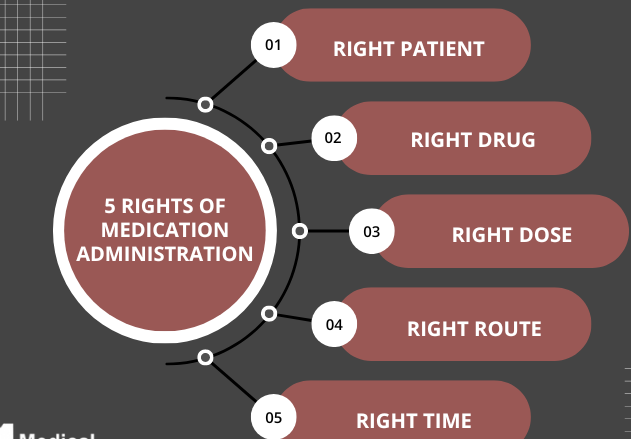 In my previous article 7 Rights Of Medication Administration, I presented the 7 essential rights of medication administration which included: right patient, right medication, right dose, right route, right time, right documentation and right to refuse. These 7 rights help to protect yourselves as nurses and maintain patients’ safety when giving out medications. This article will present the improper medication administration techniques as novice nurses and how to prevent these errors.
In my previous article 7 Rights Of Medication Administration, I presented the 7 essential rights of medication administration which included: right patient, right medication, right dose, right route, right time, right documentation and right to refuse. These 7 rights help to protect yourselves as nurses and maintain patients’ safety when giving out medications. This article will present the improper medication administration techniques as novice nurses and how to prevent these errors.
Improper drug administration can seriously impact patient safety, leading to harmful or even life-threatening situations. For you as novice nurses, being extra cautious with medication is crucial. Errors in administering drugs might seem small, however it can affect both patients and the entire healthcare team.
I believe you sometimes hear some of real-life examples show how a simple mistake, such as giving the wrong medication or incorrect dose, can lead to serious complications. Indeed, statistics highlight medication errors as a common challenge in nursing, unfortunately, nursing beginners are falling into these issues, often due to being overwhelmed by new environments and practices. Therefore, understanding the potential consequences can help you avoid panic and focus on your tasks.
The role of beginner nurses is as vital as experienced ones. You are the ones who administered medications to the patient. Your vigilance can prevent errors and ensure that patients receive drugs correctly and safely. This is the developing a mix of awareness and confidence, and with these, you can make a real difference.
Common Errors in Medication Administration for Nursing Beginners
Firstly, let discuss about the most essential part: Skipping the ‘Five Rights‘ of Medication Administration is a big one for many novice nurses. This part is making sure the right patient gets the right medication in the right dose through the right route at the right time. By not checking any of these steps can lead to making errors, so always double-check them is vital.
The next potential mistake is rushing through tasks can lead to forgetting to double-check medication orders. Despite how busy you are, take a minute to verify the details, especially with high-risk medications such as insulin or anti-coagulant. A thoughtful check can prevent serious errors.
The following part is preparing medications properly. You need to aware of crushing an extended-release tablet is not advisable. Those slow-release medications need to release slowly in the body. Similarly, ensuring you shake suspensions before you measure doses to get the right amount prior to giving it to the patient.
The last thing in this part is inaccurate measurement of liquid medications. Using the wrong tools such as teaspoons, plastic spoons instead of a proper measuring device can lead to dosing errors.
Recognizing and Avoiding Incorrect Administration Techniques
One of the most dangerous mistakes amongst “5 rights” is giving wrong route. For example, administering intravenous (IV) medications into a muscle (IM) or giving an oral medication intravenously could lead to dangerous consequences or putting patient’s life in danger. Therefore, always double-check the medication’s route before administering.
The second important aspect in administrating medication is timing. For some medications, especially antibiotics and insulin, absolutely need to be given at specific and correct times. You don’t want to give short acting insulin prior to mealtimes in case of dropping sugar level too low (hypoglycemia) instead of when patient is having meal.
The next vital component is checking for allergic reactions. It’s essential to know if a patient has allergies before giving them medication. Furthermore, observing for any signs of an allergic reaction after giving any medication is crucial.
Last but not least, patient education is paramount. Always giving patient essential education to help the patient understands what they’re taking, why, and how it’s helping them. From that, they don’t misdoes their tablets. A well-informed patient is an involved patient, making them part of the healthcare team.
Practical Tips to Prevent Medication Errors in Nursing Practice
Firstly, always obey the ‘Five Rights’. It’s your checklist before any medication distributes to the patient: right patient, right drug, right dose, right route, and right time. Keep these in mind, you are halfway of your safety.
Effective communication is your lifeline, and I can impress how important it is in nursing practice. Consult with your colleagues—whether it’s to double-check an order or just to share insights. it is always true that two heads are often better than one, especially when it comes to patient safety.
What’s about documentation? It’s a critical part of ensuring continuity of care. Making notes right after administering medications—time, dose, patient reaction—as it helps others who care for the patient later to know exactly what’s been done.
Time to talk about abbreviations. It is vital to get familiar with standardized abbreviations and don’t try to create your new ones. You then should review them if needed. When you are encounter with a confused order, don’t hesitate to ask for clarification and always remember “No Guessing”.
One of the huge issues is using aseptic techniques, it is as simple as keeping things clean and sterile. When giving IV meds or injections, make sure you’re following the proper hand hygiene, using clean needles, and prepping the area correctly. These steps help prevent infections.
Education yourself is vital, so stay informed on the medications you’re handling. It is crucial to know about their side effects and proper storage requirements. By storing them correctly will keep them effective; this knowledge is not only theoretical, but also is practical!
Lastly, observe your patients after giving a medication. Look for changes in vital signs or any other indicators that may suggest a problem. This habit will help catch issues early and address them promptly.
